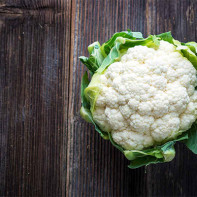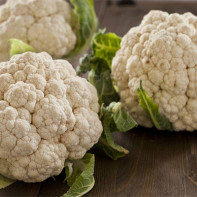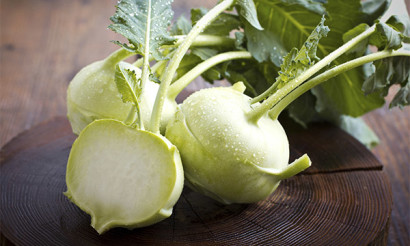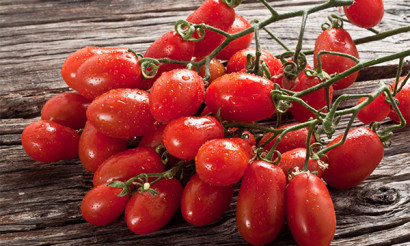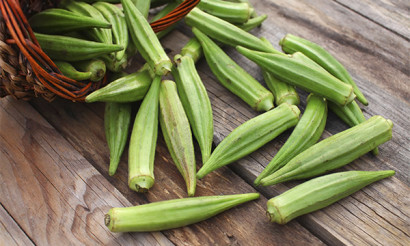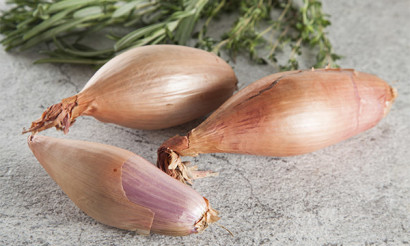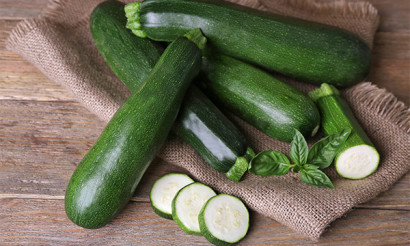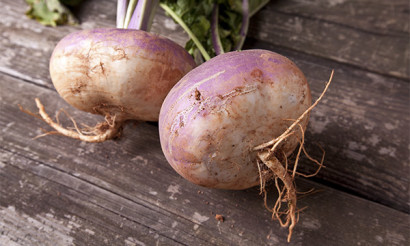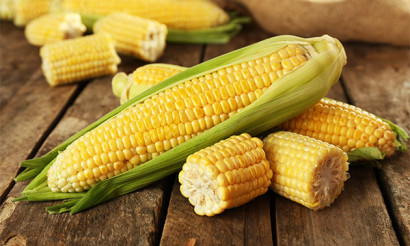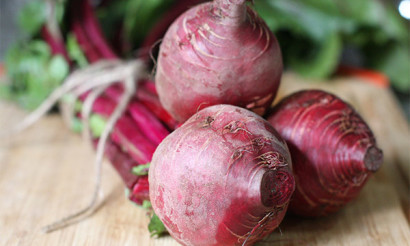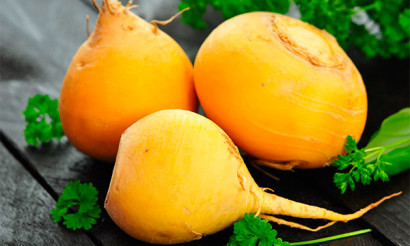Cauliflower: health benefits and harms
Cauliflower is a fairly common type of vegetable garden crop, which belongs to a varietal group called botrytis.
- What does cauliflower look like?
- Why is cauliflower so called
- What is the difference between broccoli and cauliflower
- Composition and calorie content
- What is useful cauliflower
- For women
- For men
- During pregnancy
- When breastfeeding
- For kids
- The benefits of cauliflower for weight loss
- Cauliflower in medicine
- With diabetes
- With pancreatitis
- With gastritis
- For the intestines
- For constipation
- With gout
- With colitis
- For the liver
- With hemorrhoids
- With cholecystitis
- Traditional medicine recipes with cauliflower
- Harm and contraindications
- How to choose and store cauliflower
- Is it possible to freeze
- How to Make Cauliflower Deliciously
- Boiled
- Braised
- Baked
- Fried
- Steamed Cauliflower
- Mashed soup
- Cauliflower Salad
- Cauliflower Cutlets
- Why is cauliflower bitter after cooking
- How much cauliflower can I eat per day
- Is it possible to eat raw
- Is it possible to give animals cauliflower
- Interesting facts about cauliflower
What does cauliflower look like?
Cauliflower is a very healthy and tasty product, the homeland of which is considered to be the Mediterranean. However, today this vegetable is grown almost all over the world.
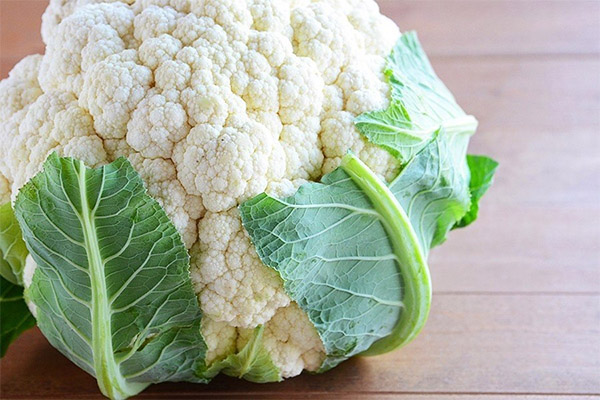
Cauliflower is an annual plant that is a subspecies of garden cabbage. It has fibrous roots located close to the surface of the earth, has a round stem with a height of 20 to 70 cm. The fruits of this cabbage are used in nutrition. They can have a cream shade, and can be snow-white.
Why is cauliflower so called
Cauliflower bears such a name for the reason that the head of this plant is presented in the form of a large inflorescence, consisting of thousands of flowering shoots. All of them are tightly pressed against each other. Such inflorescences are eaten. The people also call cauliflower curly or curd.
What is the difference between broccoli and cauliflower
You can often hear that cauliflower and broccoli are one and the same. These plants belong to the same family, but have a number of external differences. In addition, both vegetables have different nutritional composition, which indicates different benefits for the human body.
Cauliflower inflorescences have a white or cream shade, while broccoli is characterized by green inflorescences, larger in size. Broccoli bushes are much higher than "curly" cabbage.
Both vegetables are rich in vitamins and minerals, but cauliflower contains more vitamin C compared to all other types.
Composition and calorie content
Cauliflower is a vegetable rich in vitamins, minerals, each of which affects the human body in its own way. So, it contains a large amount of vitamins A, C, group B. All these elements have a positive effect on human health.
Cauliflower contains a lot of iron, potassium, calcium, which helps to improve metabolic processes in the body. This vegetable also contains pectin, which cleanses the body and helps lower cholesterol. This plant is characterized by the presence of pantothenic acid, phosphorus and omega-3 fatty acids. Eating such a product provides all the cells of the body with the necessary organic acids.
The protein content in cauliflower is almost two times its volume in white cabbage. There are also two to three times more ascorbic acid here.
Calorie cauliflower is 30 kcal per 100 g. This indicator depends on the method of heat treatment of the product. Boiled cabbage without the addition of salt has the lowest calorie content. But it is necessary to take into account the fact that such a dish turns out to be tasteless. Therefore, for a change, you can add other vegetables or sauces.The dish will turn out tasty and healthy, but its calorie content will be slightly higher.
What is useful cauliflower
Cauliflower is very beneficial for humans. This is due to the fact that it contains a large number of vitamins, macro- and microelements. Each of these active substances has a beneficial effect on many organs and systems of the human body.
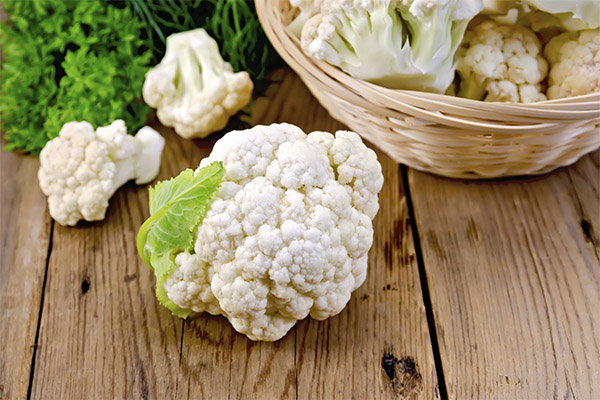
For women
Due to its low calorie content, cauliflower is a dietary product. Therefore, it must be included in the menu of women who want to lose weight. If you regularly consume such cabbage, you can reduce the centimeters in the waist.
The rich vitamin composition has a positive effect on the skin, evens out the shade of the epidermis. Due to the proper use of the product, the formation of collagen is accelerated, which allows you to get rid of small wrinkles. There are many recipes for making effective face masks.
Gynecologists advise women who suffer from painful menstruation to add cauliflower to the diet. This plant normalizes hormonal levels, protects against the occurrence of edema and discomfort. You can drink half a glass of juice squeezed from this vegetable to strengthen the body.
For men
The content of vitamin E in cauliflower can increase sexual activity in men. Also, this product will help prevent the development of prostate disease. This vegetable is especially useful for older men. To do this, it is enough to consume 100-150 g of this vegetable every day. As part of this plant, there is such a substance as diindolmethane, which can split neoplasms in the prostate gland.
As you know, problems of the cardiovascular system most often occur in the male half of humanity. Therefore, it is very important for men to add cauliflower to their diet. Potassium contained in it prevents blockage of blood vessels, improves the functioning of the heart muscle.
Cauliflower also allows you to get rid of the so-called "beer" belly in men. To do this, it is enough to eat 100 g of cabbage in the evening (from 18:00 to 19:00).
In addition to all these qualities, cauliflower is also characterized by the fact that this plant is able to put in order the person’s psycho-emotional state, helps to relieve fatigue and takes part in the fight against mental fatigue.
During pregnancy
Folic acid contained in curly cabbage contributes to the correct formation of the spinal cord and brain in the unborn baby. Since this vegetable has a low calorie content, a pregnant woman can maintain the correct weight during the entire period of bearing a child.
Regular inclusion of cauliflower in the expectant mother's diet helps to remove excess fluid, thereby preventing the formation of edema on the legs and body.
Vitamin K in the composition of the "curd" cabbage ensures the correct formation of the heart in the fetus. Phytoncides in this vegetable protect the immune system of women in position. This greatly reduces the risk of developing infections.
Important! If during pregnancy a stomach ulcer, a duodenal ulcer or gout was detected, the use of cauliflower is contraindicated.
When breastfeeding
You can supplement the diet of a woman breastfeeding a baby with cauliflower. This vegetable does not cause bloating and flatulence compared with white. This plant can be used to treat and prevent various diseases during lactation, when it is forbidden to use most of the drugs. So, the substances in the composition of such cabbage protect against the development of gastritis, problems with the ovaries, and colon.
Due to the content of a large amount of vitamin C in cauliflower, young mothers should not worry because of the usual ARVI or flu. This product protects the body from the penetration of various microbes and neutralizes them.
Cauliflower also has properties useful for intestinal microflora.This is due to the fact that cabbage juice contains bacteria that activate digestion. If you regularly consume cabbage while breastfeeding, the mother's body will function smoothly. And the health of the baby depends on this.
For kids
It is known that cauliflower is allowed for use in children. It can even be used as complementary foods for babies. Often this product is taken to feed babies who have not reached the age of one. The vitamin composition of the vegetable helps to fully develop the bones of the child.
According to pediatricians, cauliflower eliminates colic, gas and constipation in children. Mashed cabbage with the addition of other ingredients will not harm the baby's health, as it has little fiber.
The iodine contained in curly cabbage is the key to the proper functioning of the endocrine system, contributes to the development of a psychoemotional background.
In addition, cauliflower contains a lot of vitamin C, which is an antioxidant and protects the body from the effects of viruses and bacteria.
The benefits of cauliflower for weight loss
The problem of overweight worries many. Nutritionists believe that this vegetable is an excellent product for burning fat, which also reduces appetite. This is due to the tartronic acid present in such cabbage.
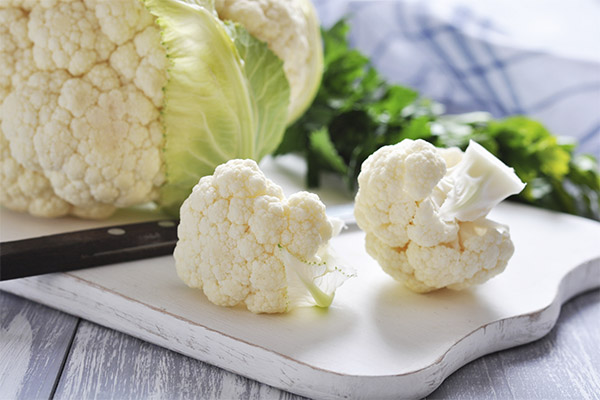
Everyone dreams of having a beautiful figure without following strict diets. This can be achieved by using cauliflower. As already mentioned, this plant has a low calorie content. Also, due to the presence of useful enzymes, fat is not deposited under the skin and around the internal organs.
Since cauliflower is easily absorbed, it inhibits the feeling of hunger, reduces the desire to eat more than the required amount and prolongs the feeling of fullness. Tartronic acid helps break down cholesterol and reduces blood absorption of carbohydrates.
Even in the case of low acidity of the stomach, do not worry that the cabbage will not be digested. This vegetable is perfectly digested in both small and large volumes. Depending on the method of heat treatment, cabbage has a different degree of calorie content.
Cauliflower in medicine
Curly cabbage is widely used in medicine for the treatment and prevention of a number of diseases. This is due to the fact that the composition of this product includes a large number of vitamins, minerals. Almost half a table of Mendeleev is contained in this vegetable.
With diabetes
Symptoms of diabetes are constant thirst and hunger, due to which a person overeats, which leads to excess weight. As a result, normal metabolism worsens. Cauliflower is one of the few products that is not only allowed with such an ailment, but it also has a therapeutic effect. So, this vegetable is a source of anti-inflammatory substances of natural origin, which relieve pancreatic edema, normalizing the formation of insulin.
Endocrinologists are advised to include cauliflower in the diet of patients with diabetes. It contains a small amount of calories, which is important for type 2 diabetes, because they are often overweight. Regular use of such a product helps to reduce weight, has a positive effect on the cardiovascular system. In addition, this vegetable allows you to establish a metabolism, remove toxins from the body and reduce blood glucose, which is very important for diabetes.
Cauliflower normalizes pressure. Due to its low calorie content, this plant is very useful for such patients. Fiber of the vegetable is slowly absorbed, and it is absorbed by almost all, prolonging the feeling of satiety. This allows you to maintain a certain level of sugar after eating. For diabetics, it is recommended to use cabbage, steamed or boiled.
A vegetable is characterized by a high protein content, and fiber is also part of it. These components do not irritate the stomach and intestinal walls. Due to the sufficient amount of protein, certain healing processes in the human body proceed faster, enzymatic functioning improves.
Important: the glycemic index of cauliflower is 15 units.
With pancreatitis
For any diseases of the gastrointestinal tract, a diet is necessary. And in this case we are not talking about a restriction on the quantity. You need to clearly know which products are allowed to be used in food and which are prohibited. This also applies to vegetables, that is, there are fruits that are beneficial for pancreatitis, and there are types that should not be consumed.
Cauliflower refers to foods that help in the treatment of the pancreas. The main nuance in this case is the form in which it must be included in the diet and with what products should be combined.
Curly cabbage with pancreatitis is an excellent sedative for the pancreas and at the same time stimulates the secretion of the stomach. A vegetable is able to saturate the human body with proteins, antioxidants. In addition, it contains vitamin U, which neutralizes toxins.
You can often hear that a healthy diet is based on the use of fiber-rich foods. As for patients with pancreatitis, the main thing for them is low calorie content and low fiber content. Cauliflower meets these requirements.
For pancreatitis, this type of cabbage is recommended to be combined with other vegetables, which are acceptable in this case. It is best to cook cabbage with vegetable soup or casserole.
The use of cauliflower with pancreatitis is allowed, however, if before the onset of inflammation the vegetable was not included in the human diet, then with a therapeutic diet, its gradual introduction into the menu is required. Servings can be increased during the period of remission, but even then this product should not be abused.
With gastritis
Gastroenterologists say that with gastritis, cauliflower improves the patient's condition. At the same time, the gastric mucosa heals faster, metabolic processes are restored, and the general condition improves. Of all types of cabbage, this variety is best absorbed, since it has the finest structure. In addition, if you properly prepare a dish from this vegetable, irritation of the gastric mucosa does not occur at all.
With gastritis, the use of raw cauliflower is not recommended. However, if we are talking about freshly squeezed juice, then it can be included in the menu.
Due to the rich vitamin composition, the presence of a large number of useful substances, the use of cauliflower leads to the restoration of damaged sections of the gastric mucosa, and the improvement of metabolic processes. Doctors call this product a natural immunomodulator, as it enhances the protective functions of the body.
Cauliflower is able to some extent increase the secretion of the stomach, therefore, it can be used by people who have gastritis with low acidity. In the period of exacerbation of the disease, it is better to abandon this vegetable.
In case of gastritis with high acidity, it is not recommended to use dishes based on cauliflower.
For the intestines
Cauliflower can improve intestinal motility. It is especially useful for breastfeeding women, because during this period the use of drugs is prohibited. You can restore the intestinal microflora by adding such a vegetable to the diet.
In addition, cauliflower contains pectin and a small amount of fiber, which helps to improve the digestion as a whole, namely to remove toxins from the intestinal walls.
For constipation
This vegetable is perfectly absorbed by the body, excluding intestinal irritation.Cauliflower helps ensure that bowel movements occur on time. If a person suffers from constipation, he should regularly use this vegetable.
With gout
If a person has a disease such as gout, cauliflower is not recommended for him. Purines present in cabbage accumulate in the body and cause urea deposition to begin.
If there are problems with the urinary system (kidneys), plus a person suffers from high blood pressure, he should eat this vegetable with caution, it is best to consult a specialist.
With colitis
Colitis is a disease of the intestinal mucosa that interferes with its normal functioning. As a result, there may be problems with excretion of feces, absorption of fluid, intestinal motility. This disease manifests itself with constipation and diarrhea.
Against the background of exacerbation of colitis, cauliflower should not be used. Usually, during this period, treatment consists in fasting, and then in a gradual transition to sparing food. Of all types of cabbage during the diet, only cauliflower is allowed only during the period of subsidence of symptoms. Patients with colitis can consume such a stewed or boiled vegetable. Fried cabbage with this disease is unacceptable.
For colitis with diarrhea, it is recommended to limit the use of cauliflower. If colitis occurs against a background of constipation, this vegetable should be taken regularly, as it enhances intestinal motility.
For the liver
The liver works on the principle of vacuum, that is, it constantly absorbs harmful and useful substances. If it functions normally, its surface should remain smooth. If there is intoxication, then changes occur in the liver, the degree of which depends on the stage of the disease.
The liver takes part in digestion, it also purifies the blood in the human body. This allows you to distribute nutrients throughout the body. If harmful foods are present in the human diet, liver function is impaired. And in this case, it is recommended to add cauliflower to food. The purpose of the vegetable in this case is the removal of all toxins from the liver.
With hemorrhoids
Hemorrhoids are a disease that occurs in every fifth person in the world. This ailment brings a lot of discomfort to a person’s daily life. The main way to treat this disease is to take medications and follow a special diet.
A diet using cauliflower helps get rid of hemorrhoids. This is due to the fact that this vegetable has a strengthening effect on blood vessels, prevents bleeding. The plant also helps relieve pain and reduce inflammation. In addition, curly cabbage has a regenerative effect on damaged tissue. Another advantage of cabbage in the treatment of hemorrhoids is that this product helps get rid of pathogens.
With cholecystitis
With this disease, cauliflower can be used both as food and as a treatment. It enhances the outflow of bile, which is very important at certain stages of the disease. As a food product, this vegetable can be used to make soups, or simply boil or bake in the oven.
With exacerbation of cholecystitis, it is not recommended to use cauliflower.
Traditional medicine recipes with cauliflower
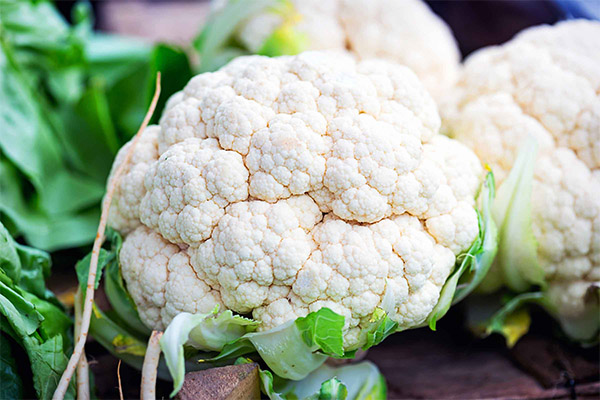
- Cabbage juice normalizes the digestive tract, helps to get rid of constipation. To do this, you should drink 100 ml of freshly squeezed juice half an hour before breakfast.
- Pickled cabbage brine helps in the fight against hemorrhoids. For this inflorescence of the vegetable should be cut into small pieces, salt and place in a bowl with a lid. After a couple of days, the cabbage will start up the juice. It must be taken one hour before meals, twice a day, 100 ml. Repeat the procedure until the symptoms disappear.
- Cauliflower compress treats burns and wounds. For this inflorescence, the plants should be crushed in a blender and add a raw egg.The resulting mass must be applied to gauze and applied to the site of a burn or wound for several hours.
Harm and contraindications
The use of cauliflower is harmful for patients with acute enterocolitis or a duodenal ulcer. Otherwise, the situation will only worsen, there will be pain in the stomach, as well as intestinal obstruction.
If abdominal surgery has recently been performed, the use of cauliflower is not recommended. Also, doctors do not recommend consuming cabbage in case of exacerbation of gastritis or gastritis with high acidity. It is necessary to abandon the product in case of gout, as well as in cases where there is an allergy to the vegetable.
If a person has a tendency to indigestion or flatulence, this useful product should not be used. If after taking a dish of cabbage there is discomfort or pain, the vegetable should be excluded from the diet.
How to choose and store cauliflower
When choosing cauliflower, you should pay attention to the quality of the vegetable.
- Leaves, inflorescences and heads of vegetables should not have mechanical damage and any pollution.
- Inflorescences of the product should fit snugly together.
- The weight of the cabbage should match the size of the plant. If big cabbage is too light, then chemicals were used for fast growth.
Cauliflower can be stored fresh in the refrigerator. To do this, it is necessary to separate all the inflorescences of the vegetable from the greens and wrap them in paper or cling film. For a long time, cabbage can be stored in the basement or in the cellar, if any. To do this, just hang the heads of cabbage. Inflorescences remain intact.
You can store the product on the balcony. However, it is important to ensure that the temperature does not drop to negative values.
If cabbage is stored in a cellar or basement, the shelf life is six months, in the refrigerator - no more than a week. If we are talking about the balcony, then here the product can be stored for about a month, subject to all conditions.
Is it possible to freeze
To save curly cabbage for the winter, you can use the freezer and freeze the vegetable. Before this, the plant should be disassembled into inflorescences. They can be boiled in water with the addition of salt for no more than five minutes. Then you need to thoroughly dry the product. After this, the cabbage is laid out in containers or in packages (it is advisable to indicate the date of harvesting).
It is recommended to shake the frozen vegetables regularly so that the inflorescences do not freeze into one large lump. Repeated freezing is not allowed. In this form, cauliflower can be in the freezer for a year.
You can freeze fresh cauliflower, however, in this case, vegetable damage is possible.
How to Make Cauliflower Deliciously
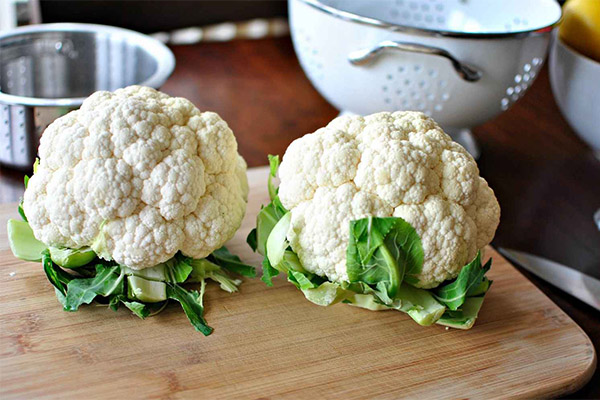
Boiled
To cook boiled cauliflower, divide the vegetable into inflorescences and lower them into boiling water for 6–7 minutes. It is not recommended to keep them in boiling water longer, otherwise they will boil, and the dish will turn out tasteless. You can add a little salt to the water.
Braised
To cook stewed cabbage, chop the onion into strips, carrot into cubes, fry the vegetables in a pan with olive oil. When the onion gets a golden hue, you need to add coarsely chopped sweet pepper. The resulting mass must be fried for another 5 minutes. After that add green peas, salt, pepper to taste and finely chopped garlic. Next, add the inflorescences of cabbage and pour half a glass of water into the pan. Simmer for 10 minutes without stirring until all the liquid has boiled away. Then you can gently mix the vegetables and put on a plate.
Baked
A small head of cauliflower should be boiled whole in a large bowl for 5 minutes. Then you need to preheat the oven to 200 degrees. Grease the cabbage with mayonnaise and sprinkle with cheese, previously crushed on a grater. Bake the dish until golden brown.
Fried
First you have to boil the cabbage in water with the addition of salt. It is important that all cabbage is in the water. To check readiness, you need to pierce the vegetable with a fork: it should be soft, but not boiled. Next, prepare the batter. To do this, beat eggs with milk and add two pinches of salt, gradually introduce flour.
Boiled cabbage should be divided into inflorescences. Then you need to heat the pan with vegetable oil. No need to wait until the oil becomes hot, otherwise the cabbage will burn on the outside, and inside it will be raw. Each inflorescence must be dipped in batter and fry on both sides in oil.
Steamed Cauliflower
First you need to clean the head of cabbage from the leaves and rinse the cabbage. Next, dry the vegetable and cut into inflorescences. The resulting pieces must be laid out on a wire rack and add salt and pepper to taste. Then the grill should be installed in a device with boiling water. The dish is cooked for 15 minutes. Cauliflower readiness is easily checked with a fork. The finished dish can be served with sour cream or olive oil.
Mashed soup
To make soup, boil cabbage with onions, carrots and tomatoes for 20 minutes. Next, the whole mass must be crushed using a blender. At the end, you can add a little salt to taste. Before serving, you can season the soup puree with a small amount of oil and sprinkle with herbs.
Cauliflower Salad
To prepare a salad of fresh cabbage, you must first rinse the vegetable and divide it into inflorescences. You can use a raw product or lightly scald it. Next, fry the diced bread without butter. Then cut into strips 2 peppers, cubes - 2 tomatoes, 2 eggs and one onion. You also need to chop the greens and grind one carrot. All ingredients must be mixed and seasoned with spices to taste.
Cauliflower Cutlets
To prepare the cutlets, you need to prepare a head of cabbage, a couple of chicken eggs, a little flour and vegetable oil. Rinse and boil the curly vegetable inflorescences. Then pass the inflorescences through a meat grinder, mix the resulting mass with eggs, add salt to taste. Then form cutlets, roll them in flour and send for frying in a pan with vegetable oil. Ready cutlets can be poured with low-fat sour cream.
Why is cauliflower bitter after cooking
The first reason for the bitterness of this product is the failure to comply with the standards when growing or lack of moisture. Bitterness also appears in the case of excessive nitrates in the product.
To remove the bitterness, boil cauliflower in salted water. You can also soak a head of cabbage in acidified water, but it will take more time. Some housewives get rid of bitterness by treating the vegetable with a solution of vinegar or fresh lemon juice.
How much cauliflower can I eat per day
If there are no contraindications, cauliflower can be consumed in unlimited quantities. People with gastrointestinal problems are recommended no more than 150 g per day. For pregnant women, 50 g per day is enough 2-3 times a week. Lactating women can include this product in the diet a month after the birth of the baby. The dish should be introduced gradually, increasing the volume to 200 g per day.
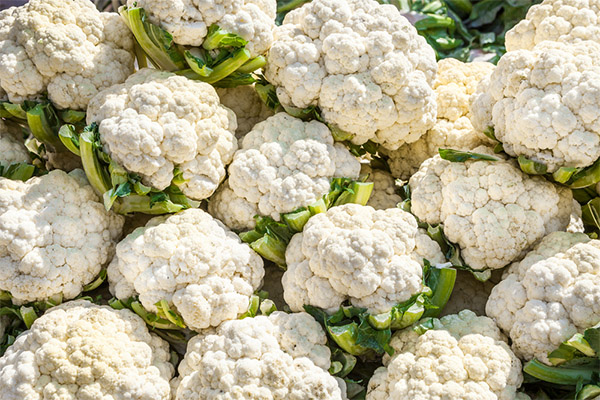
Children can be given cabbage after 6 months, starting with a teaspoon. Gradually, you can increase the portion to 100 g no more than twice a week.
Is it possible to eat raw
This product is quite suitable for use in its raw form. At the same time, the largest amount of vitamin and beneficial elements is preserved.After heat treatment, part of the vitamins evaporates, they become less.
Is it possible to give animals cauliflower
Most pet owners are wary of including cauliflower in their pet's diet, but in vain. This vegetable is very well absorbed by the animal. It contains less fiber (compared to a white relative), therefore, it is easier to digest and does not cause irritation of the gastric mucosa. This property of the vegetable is indispensable when feeding sick and weak pets with gastrointestinal problems. You can give it raw, but it’s better to boil it.
Interesting facts about cauliflower
Few people know, but in addition to the usual name for everyone, cauliflower is also called Syrian. This is due to the fact that Syria is the birthplace of this vegetable. From there it came to the island of Crete, and then its seeds reached France and Italy, where it began to be grown back in the 14th century. In England, they began to cultivate cabbage in the 17th century. The British cooked the plant in milk and served on a plate separate inflorescences.
Russia began to cultivate cauliflower only under Catherine the Great, but only the rich could afford such a product, since it was very expensive.
The most common is cauliflower milky or cream shade. But there are other, more exotic varieties of unusual colors. For example, Cheddar has orange inflorescences and contains large amounts of beta-carotene. The Purple Ball is also popular - the flesh of such cabbage is rich in anthocyanin, very useful for blood vessels and vision. The Amphora species is characterized by pyramidal inflorescences, which have a bright green color due to the large amount of chlorophyll in them.
«Important: all information on the site is provided exclusively in fact-finding purposes. Before applying any recommendations, consult with a profile specialist. Neither the editors nor the authors are liable for any possible harm caused materials. "





